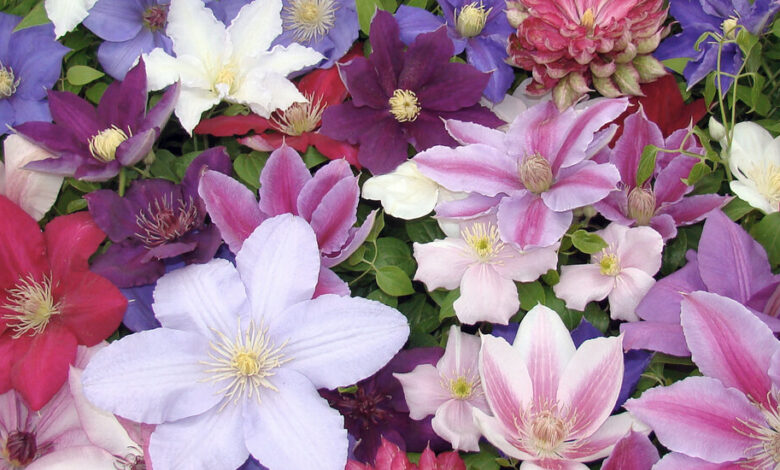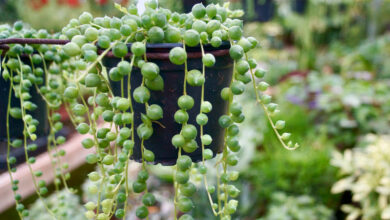How to Make Clematis Flowers Last All Season

It’s hard to imagine that the aphorism warning about too much of a good thing could ever apply to Clematis, whose charming flowers and mostly lightweight climbing vines make them irresistible.
Dan Long, of Brushwood Nursery, in Athens, Ga., certainly has never been scared off by the prospect of overdoing it. Mr. Long has amassed a collection of more than 400 kinds of Clematis. He can count on them to bloom from early spring through late fall, but he always has his eye out for exceptional additions — more native species, perhaps, or varieties with a particular fragrance.
He is quick to note, however, that you don’t need a collection the size of his to achieve a season-long Clematis display: It’s within reach of every garden. But it does require a strategic choice of varieties, based on staggered bloom times. You also have to master what Mr. Long calls the “refreshing techniques” that can coax maximum flowering.
Even the Clematis you’re already growing may have more to offer than they’re currently delivering, with a little well-timed advice from someone like Mr. Long, who started Brushwood Nursery 25 years ago. His onetime “scrappy nights-and-weekends” project — which began in a rented greenhouse in Kennett Square, Pa., from which he sold plants on eBay — moved south to bigger quarters and a longer growing season in 2010, and now ships more than 6,000 orders a year.
Getting an Earlier Start
Although large-flowered hybrids like Henryi, with its ample white blooms, and velvety-red Niobe are the most familiar varieties, you’ll have to wait until late spring for the show if those are the only Clematis plants in your garden. You can change that by shopping for Clematis the same way you would for tulips or Narcissus — by tracking down early, midseason and late varieties.
The show will start earlier with varieties of Clematis alpina, with their smaller, nodding flowers, Mr. Long said, or C. macropetala, whose blooms are sometimes described as resembling double-flowered columbines.
Clematis montana blooms early, too. That extra-vigorous, pink- or white-flowered species, which can grow to 20 or 30 feet, easily covers a pergola or fence. The montanas are less hardy than many other Clematis, though — only to Zones 6 or 7.
If you want early flowers as well as distinctive fragrance, consider two 10-year-old introductions, Sugar-Sweet Lilac and Sugar-Sweet Blue, offspring of Clematis cadmia. Mr. Long describes the blue selection as having “a wonderful gardenia-like scent” and the lilac as smelling like orange blossoms (or maybe lemon with a touch of vanilla). Both have three-inch flowers on vines reaching around six feet, making them good candidates to grow in a big pot that can be moved around the patio for up-close enjoyment.
Are You Watering and Feeding Enough?
The popular large-flowered hybrids, with blooms as big as 10 inches across, start flowering next.
But “there are seasons within them, as well,” Mr. Long noted. Certain varieties start later than others, another chance to subtly stagger the display.
There is a more dramatic tactic, though, that many of us haven’t tried: Cut the vines back to a third of their height after they bloom, he suggested, as this may prompt a later flush of flowers. We do it with perennials like catmint (Nepeta), so why not Clematis?
Follow the haircut with an application of an all-natural organic fertilizer and deep, thorough watering. Mr. Long recommends Espoma Rose-tone — “because there is no Clematis-tone … yet,” he said, smiling. An organic tomato fertilizer would also work. Follow the label directions regarding frequency and the amount to use.
For gardeners with any Clematis that isn’t blooming well, there may be an insight to glean from that trick, he said: Your plants may want more fertility and deeper watering. Although Clematis can live for up to 50 years, their needs are misunderstood, owing to a much-repeated myth that says they “like their feet in the shade and faces in the sun” — as if that’s the full prescription.
“That’s a simplification,” Mr. Long said. “What’s true is that they need a lot of water during the growing season to perform their best, and people think shady spots are moister. But then all those shade plants growing around their feet compete for resources.”
The upshot: Your Clematis plants don’t get enough.
When to Prune? The Plants Will Tell You
Another place we get off track: When to prune which Clematis?
The timing is usually explained relative to the pruning category a plant is in — Type 1, 2 or 3 — but gardeners who don’t know the type they have (or maybe even its name, to research the type) may be at a loss.
The reveal is right in front of us: The easiest way to know when to prune is based on when a plant blooms.
All the early bloomers (Type 1) set their flower buds on old wood, so it’s best to prune out damaged or stray stems after they bloom, to tidy up the plant.
At the other extreme, late-flowered Clematis (Type 3) bloom only on new wood, and are the easiest of all to prune: Cut them nearly to the ground just before growth begins in spring.
Most large-flowered hybrids (Type 2) can bloom on old and new wood — meaning they are capable of repeat flowering. In late winter or early spring, when their buds begin to swell, cut just above the fat buds, either lower or higher on the vine.
“Typically you want to get low,” Mr. Long said. “But a lot of Type 2s are genetically complex and can be treated like Type 3: Cut back hard, so you only get flowers on new wood.”
Blooming will start a few weeks or a month later than usual, so experiment, he advised.
Summer-Into-Fall Performers
Summer- or later-blooming Clematis are especially good for growing up and over an early flowering shrub that will be green afterward. For example, you can really dress up a Forsythia, Mr. Long said, with the four-inch-wide, summer-into-fall pink flowers of Comtesse de Bouchaud.
In between the earliest and latest large-flowered hybrids are some long-blooming standouts with the species Clematis viticella in their genes: Madame Julia Correvon, Betty Corning, Etoile Violette and the dramatically striped Venosa Violacea can all produce several flower flushes.
Another choice, from different parentage: Paul Farges (or Summer Snow), which produces many weeks of frothy, white flowers. At 15 feet or so, it is best grown over a fence or wall, or even up a small tree.
For summer and fall flowering combined with the surprise of the color yellow — an uncommon hue in Clematis — try C. tangutica.
The common name “sweet autumn clematis” used to be synonymous with late-season bloom, but Clematis terniflora is now known to be invasive and should not be planted. The native C. virginiana, “though not quite as flashy or fragrant,” Mr. Long said, makes a smart substitute if later frothy, white blooms are wanted.
It is just one of many small-flowered natives with long bloom seasons to consider, including various members of the Viorna group that are native to the Southeast and lower Midwest, even straying into the Rockies a bit. Some viornas have earned the common name of leather flower for the thick-textured sepals of their pendulous, bell-shaped flowers.
Clematis crispa, another mostly Southeastern species, makes blue-and-white flowers that resemble small bells. Similarly shaped, red-flowered C. texensis is a Texas native.
Just Getting Started?
Can a man with so many Clematis plants possibly name just a few that a garden should not be without?
Mr. Long is especially fond of H. F. Young, which produces big, pale blue flowers in late spring that repeat in late summer. And “Polish Spirit is an easy win,” he said of the purple-flowered climber that shows off from midsummer into autumn.
“So is Arabella,” he said, describing it as “a scrambler,” with flowers that start off blue-mauve and fade to pale blue. Use it as a ground cover, he recommended, or let it weave among your perennials.
A newer variety, deep blue Hudson River, blooms all summer, and at only four or five feet is likewise well suited to mingling among perennials.
And then there are the non-vining ones he terms “blooming machines,” including some outstanding hybrids of Clematis integrifolia, a herbaceous species that grows to only about three feet. (Hudson River and Arabella both have integrifolia in them, in fact.)
“Some of the better integrifolia hybrids just go and go,” he said. Mississippi River is another he especially likes.
On the subject of non-vining types, perhaps the most distinctive are the Clematis recta purpurea varieties, including Serious Black (also known as Lime Close) and Midnight Masquerade.
And yes, there’s a trick to urging multiple shows from them as well — although one with a bit of a twist.
“Some people really like that fresh purple, so they’ll cut it back when the foliage fades to greener, just to get more of the darker color,” Mr. Long said.
That may not result in additional flowers, but it still amounts to an extra performance from yet another happy-to-cooperate Clematis.
Margaret Roach is the creator of the website and podcast A Way to Garden, and a book of the same name.
For weekly email updates on residential real estate news, sign up here.
Source link






